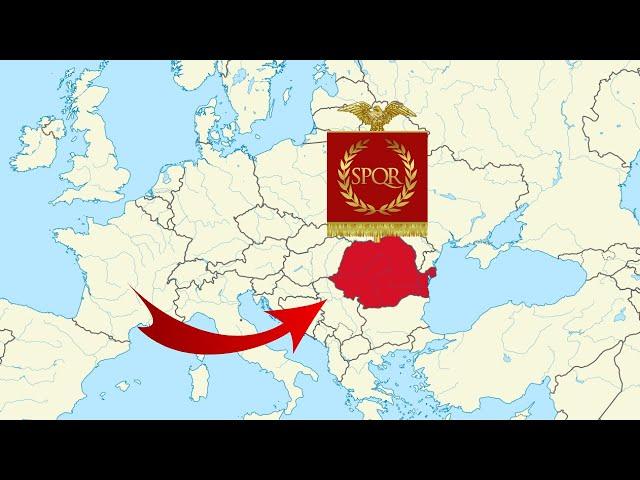Комментарии:

That would be Greece, albeit for various reasons after our liberation we were prevented from pursuing our Roman Byzantine Past, we were the ones who used and some still use the Name "Romania" and "Romaios"
Ответить
In ROMANIA LIVE BARBARIANS DACIANS 😂
Ответить
What about the Venetians? 🤷♂️😂
Ответить
Adapt to your new conquerors ways or be deported and/or enslaved. Any remaining behind better learn to completely adapt and be latinized, especially after we import true Latin immigrants which will seal the matter into perpetuity. Get used to it.
Don't whitewash history or the cruelty associated with it.

latin and its children Spanish French Italian and others are poetic languages and the people love their Latin based langues so they kept them,
Ответить
Hey, we need an hour of Pannonia!
Ответить
Sponsian was not a Roman emperor, his coin is a 17th century falsification to scam coin collectors.
Ответить
The last Romans live in Greece open a book and learn some basic history
Ответить
🤔👍👍
Ответить
I never knew you were Rumanian. Maybe you are a descendant of Romans
Ответить
If Hagia Sophia means something to you your probably Roman!
Ответить
Space nerd here following you to Rome.
Ответить
Interesting perspective; while I think it's possible that there was some truth to the migration theory, in that some Daco-Romans probably did move south, and later back north, I doubt it's the prevailing ethnogenesis of the Romanian people. First, one must remember the mountainous nature of Romania and how it's easy for a population to survive for a very long time in the forested mountainous areas of the Carpathians (and Apuseni) mountains, virtually immune to the waves of invaders in the lowlands. The same explains the long-term survival of people in places like Afghanistan or Greece's Mani peninsula, where Pagans thrived until 1000 years ago.
Second, note the sub-languages of Romanian outside Romanian, notably Aromanian, Istro-Romanian and Megleno-Romanian, scattered throughout the Balkans; these are likely small remnant populations of the much larger Latin-speaking populations of Late Antiquity. Despite the much longer Latin presence south of the Danube, only these small groups remain, which makes little sense in the context of a migration theory to the north. These languages are also much more heavily Slavic-influenced than Romanian is.
Indeed, the brevity of the Roman occupation of Dacia might explain why Romanian is closer to Latin: it separated from the evolving Latin world earlier than the languages that later became Italian, French, Spanish and Portuguese; while these languages influenced each other for centuries onward, drifting away from Latin, Romanian's greater isolation kept it closer to the original Latin, similarly to how other languages in isolation retained a form close to their original language. A good example is Quebec's French, which sounds much closer to pre-French Revolution french than does French in France itself, which has changed in the last 300 years more than Quebec French did.

So who was first in transylvania?
Ответить
We don't call ourselves romans in our language. It is a difference between roman and român
Ответить
Rome was and still is the greatest civilization...
well worth the effort to research and read from 753BC to about 1453AD
there are thousands of tales of diplomacy, generals and benevolence that still apply today.
Gibbon is a good start.... then go back to Plutarch, Tacitus, Livy, even Caesars memoirs....
Plutarch's 'The Lives" is actually a great start... so well written and parallels famous Greeks and Romans.

I think you're forgetting some key factors, Galerius's claims, the eastern roman diplomat's claims when he was at Atilla's court, the many roman captives taken beyond the Danube from both Moesias during the gepid, slav, avar and bulgar migrations. The more plausible ethnogenesis is on both sides of the Danube, from the Middle part(where the Hungarians found romanized peoples to the Black Sea littoral)
Ответить
Is there evidence that the Romans were strategic about which areas they fought to keep? Like would they fight for land that didn’t have metals simply for the glory of Rome?
Ответить
The "Daco-Roman" theory of course has been debunked. The Wlachs - which was a broad term - migrated later from other parts of the Balkans in Medieval times to what is the country of Romania today as opposed to already having been there: there were Latin speakers living in other parts of the Balkans and they were broadly referred to as the Wlachs, but these Wlachs were not found in what is today the country of Romania until later migrating there. It is just too much for Romanian nationalists to accept that their origins lie outside of what they call their country today and they are not some magical Daco-Romans as their carefully constructed national myth would have people believe.
Ответить
Austria and Switzerland were the first provinces and had more Roman culture than romania which was the last province and which was not even completely conquered..you and your country have nothing in common with the romani.Italia was Ager Romanus that is an extension of the city of Rome, romania was a simple and irrelevant province..furthermore, after Italy, the country that has the most Roman culture is Greece which has never spoken a language that derives from Latin
Ответить
romania is dacian not roman
Ответить
romania has nothing in commoun whit romans..romans was an italic people
Ответить
It makes sense to me that Romans from all of the former Rome moved there eventually with many migrations as Slavs took ground on the Balkans and German tribes were taking over Italy. And this process lasted for a very long time at least 500 years. And why this happened well maybe there is a lost history of the region, maybe in those times Romania was actually prosperous region capable attracting old romans.
Ответить
Ευχαριστώ πολύ❤
Ответить
What if the Dacia people were already speaking a version of Latin before the partial Roman conquest of their country? Think where the Romans originated, based on the legends
Ответить
Thanks!
Ответить
Excellent Vídeo.
Ответить
Dacia was rich resources like iron and salt resources the Romans needed. However looking this part of history Dacia was part of Rome for about 150-170 years at most and was by far the least important province in the Roman empire. Such a short span would not have been enough to Romanize the part of Dacia the empire actually controlled let alone Romanizing it in it's entirety. I'll come clean im a Bulgarian so it's Ok to call me biased or accuse me or us of having some territorial claim at Romania which i and we(Bulgarians) do not have this is the internet after all but let's look at it. Here is a pretty good example for what im trying to get at. The first Danube Bulgarian empire is called that way cause the Danube river was right in the center of it. This Bulgarian empire was conquered by the Romans and remained under Eastern Rome(Byzantine) rule for about 160-165 years some of the population and aristocracy were transferred to Asia minor but the Asen brothers who began plotting how to restore Bulgaria came from somewhere up north from the Danube a territory that was part of the Bulgarian empire yet the Romans were not interested in despite it being populated by a Latin or Romanized speaking group? This here is where everything for Romanians falls apart. The Asen brothers succeeded and restored Bulgaria however language and customs did not change. In an extremely short span the two brothers gained control over most of modern Romania(Transylvania was lost to the Magyars after the first Bulgarian empire was conquered by Basil II) and they did that without a drop of blood. How did they do it? Well i guess because those on the other side of the Danube were just as much Bulgarian as those on the south. Let me explain. Let's go back before the breakup of the Roman empire. The Roman were famous for their generosity for those who had accomplished greatness for those who have benefited the empire, the emperor or some other rich noble often they were granted lands to do as they please in some part of the empire. However the right to the richer provinces was almost exclusively granted to those with Roman blood. The citizens of Rome i.e those who had been or were in the process of being Romanized were granted lands from the laser provinces. This would suggest that it was highly unlikely that Rome would restore a portion of Dacia's population after the Romano-Dacian wars. Even less likely they would send their own in to the fringes of the empire in to their poorest province which was constantly under some form of assault. After the Hunic empire fell apart proto-Bulgarian tribes began settling the territories between Pannonia and the Pontic-Caspian step(the Caucasus included) However our true mark on this world was when Kanas Boris ordered everyone in his empire including everyone on the territory of the former Dacian province to be baptized and converted to his version of the Orthodox faith. The conversion meant that everyone was re-bourn with a new life and had to choose a new Christian or Slavonic name. This was why most of the greatest Romanian historical figures had names similar to those in Bulgaria including the notorious Vlad the III the Impaler whos actual name was Ivan Valadislav or Yoan Vlad.
Ответить
How do you explain, that a LATIN LANGUAGE, was spoken in territories that were NOT CONQUERED by the Roman Empire? North-East and North-West.
There is a THEORY that LATIN originated from ROMANIAN. How about that?

As a romanian i can Say this is a bullshit
Ответить
how come no other province wich was way longer under Romans DONT SPEAK ROMAN LANGUAGE?!?
their language is XIX century projekt to divide Russians from Serbians...till than they spoked Slavic(and this is what they are)...SLAVS

Romanians are just Slavs with a Latin language, change my mind
Ответить
We are not Romes descendants. The name România comes from the transilvanian students in the 1800s in an attempt to gain sympathy from the west in our struggle for independence from the ottomans. There are theories that Dacian was very similar to latin.
Ответить
Hello! I salute your interest in history of the Romanian people. But I think the "stay behind" theory is close to be the correct one. First, there is no massive migration north of Danube of the latin speaking population mentioned in any records in a region that was very important for the Byzantine Empire. Second, why a migration north of Danube of a sedentary population when everything was easier south of Danube, there is no migration north of Danube in the whole history of the area! Every migration since indoeuropean one was made from the north to the south(showing that there are advantages going south); third genetic analisys show that population in the Panonian-Carpato-Balkano-Danubian region is almost the same as the one form post indoeuropean migration with minor variations in different regions(below 15 %); so the majority of the people is clear indigenous. The slavic influence is certain the most important one but small all the same. Regarding the language, my opinon is that vulgar latin was spoken in Dacia long before the Daco-Roman wars and continued to be the one predominent after the Aurelian retreat of the adminstration, military and a small part of the wealthy citizens. Third, as I said before every transdanubian migration was made from north to south even the great slavic one and that is the reason for the slavicisation of the former roman provinces of Thracia, Moesia, Iliiricum with small pockets of latin speaking population(vlach-the exonim term used for latin speaking populatin by germanic chronicals). The steppe migrators(hunnic, magyar, avar, cuman) were interested in rulling not distroing the indigenous population so probably the sistem of ruling was similar to the one the mongols imposed in Rusia, comunities living by their own rules, customs, ruled by their own chiefs but paying tribute and military support to the military elite. That's why vulgar latin rsisted in these parts, because the only migrators interested to settle, the slavs, had minor interests in staing in these lands
Ответить
The last romans lived in Romania where they were assimilated by the gypsy populations
Ответить
Hungaria din’t exist in that period ( year 250).Hungaria was founded by union of some tribes in eight century by Arpad; as a state in 1000, by Stephan; hungarians were the last migratory people in Europe
Ответить
The ancient romans were simply obsessed with the dacians even before the Dacian Wars, when the Roman Empire paid tribute to Dacia(shocking, I know) to not invade and pillage the empire territories), but also after the annexation of former Dacia as Dacia Felix into the Roman Empire. As a proof of the romans obsession with Dacia and the dacians, just look at how many statues of ancient dacians are today spread all over Rome. Only the Arch of Constantin has 8 dacian statues above its columns(taken probably from the Trajan Forum when Constantine built his arch in the early 300s). 😁😃
Ответить
Im half romanian. This is very interesting 😂
Ответить
I find it impossible to evacuate 500.000 - 1.000.000 people in the 200s, logistically. It's possible that some of the Daco-Romans moved to the mountains while others left for south of the Danube. However, I do find the migration theory to make much more sense because of place names, 500 years and language. However, what if the Romanians came back earlier than in the 1200s as the Hungarians claim? There are works such as the poem Nibelungenlied from the early 1200s mentions one "duke Ramunc of Wallachia" in the retinue of Attila the Hun, the 11th-century Persian writer, Gardizi, wrote about a Christian people "from the Roman Empire" called N.n.d.r, inhabiting the lands along the Danube. He describes them as "more numerous than the Hungarians, but weaker". Historian Adolf Armbruster identified this people as the Romanians. Hungarian historiography identifies this people as the Bulgarians. The Primary Chronicle of the Slavs mentioning the Romanians/Vlachs north of the Danube and in Transylvania, the Gesta Hungarorum again mentioning the Romanians and Gelou in Transylvania. This to me, while I agree that the immigrationist theory makes sense, seems too much of a coincidence to be all fakes. You can't have so many people lying about a specific event. Sure, you can have Gesta Hungarorum's author like for some reason "glory to Hungary they beat the Romans" or something like that, but when there's written evidence of more unrelated people saying the same thing, that there are Vlachs north of the Danube, I find it hard to believe that they all lied. It's not like we find some 5 random sources about Spaniards in France, something must have happened there for 5 random sources to exist.
Ответить
As a Romanian, thank you for making this objective video! "History" is full of Romanian nationalist and Hungarian nationalist propaganda. With Romanian historians saying "there's no way the Daco-Romans moved south of the Danube, it's impossible" and Hungarian historians saying "there's no way the Daco-Romans continued to live North of the Danube". Why? Trianon. If the Romanians came after the Hungarians in the 12th century, that would make Trianon less justifiable since the Romanians were the ones who came after them. But if the Romanians remained in Dacia, that would make the Hungarians "the bad guys" since the Hungarians came after them and the Romanians just got independence. Basically "who was first". So again, thank you for making this objective video!
Ответить
It's hard to believe that such a significant population movement in such a short period from the north of the Danube to the south remains unnoticed and there are no historical written sources. And then the other way back movement happens so slowly that Latin speaking population ends up being the most numerous among their Slavic neighbors. Romanized Slavs or Slavicized Romans?
Ответить
Scythia minor and southern parts of Dacia ( righbank Danube in what is today's Oltenia) were under Roman infleunce and on/off control up to the 6th century ( Constantine, Justinian, Maurice)
Ответить
If there were remining Daco-romans ( that would have been mostly latinized paleobalcanic people like Dacians /Thracians and possibly also Illiryans) then they as the archeological record shows they will have mixed with the newly arriving immigrant slavic and later bulgaroslavic elements. Probably already beginning in 5th or 6th century.
A later additional migration of Balkanromance qddition from areas of Northern Bulgaria/Noetheastern Serbia possibly even northern<acedonia is what mostly
Liked lead to the Romanian lands establishing its Romance character instead of a slavic one like the surrounding areas
.
In fact we know from history that the one of the pooulation centers of northern Vlach settlements around the 9-10th century must have been northen Bulgaria aka Paristrion/Paradunavon up to the Balkan Mountains (Haemus Mons) an area also called Blachia or Vlachia or Asprovlachia in old documents

Today's Romania was part of 2 Roman provinces (Dacia was even more province) Dacia and Scyhtia minor (todays Bulgarian & Romanian Dobrudja region on the Black Sea coast)
For a time Roman influences/power extended well intoo todays southern Ukraine with Oliba pontica close to modern Mykolaiv and other colonies on Crimea

What is really fascinating is the resistence of the romanian language during the test of time, while surrounded by slavonic and other languages
Ответить
When I edit this reality, what I think I will do is that I will make sort of a continuous existing civilization similar to China but out of the Western World from Spain and Britain to India and East Africa. Pretty much the extent of territory found in Crusader Kings III. And I am going to make a series of rises and falls concerning the same territory in which language changes and evolves, but the institutions remain relatively the same throughout that span of time and there is an obvious transitional phase which allows you to see it all as one continuous system.
I want to start this before the Bronze Age Collapse by increasing Egypt's development as a Bronze Age Civilization so it is in good shape, not too good to destroy the Hittites as that might prevent the Bronze Age Collapse altogether and the Bronze Age Collapse is necessary to make the conquist and rise of a Great Egyptian Empire possible. It won't last that long, pretty much falling before the rise of the Israeli Empire that will replace it. Essentially, the Empire continuous to get conquered from within by an assimilated or half-assimilated population much like if Rome was conquered by Greeks after the Greeks were Romanized, which did happen when the Eastern Romans conquered the Ostrogoths. Don't think it is going to start off with Egyptians conquered Britain. More like conquering the lands of the people who had prior existing civilization in some concrete form.
Egyptian Empire -> Israelite Empire -> Aramaic Mesopotamian Empire (Just called the Mesopotamian Empire, although it called itself the Beth Nahrain meaning the same thing, which moved it capital from the North in Assyria to the south in Babylon) -> Persian Empire -> Macedonian Empire -> Roman Empire -> Byzantine Empire with Aromanian as its State Language instead of Greek -> Frankish Empire -> Norman Empire with Norman French -> Turkish Empire with Ottoman Turkish -> European Empire with Luxembourgish as its State Language (Also moves it capital from Paris to Vienna to Berlin) -> American Empire
What happens during each Imperial Phase. I cannot cover everything. The increase in life expectancy should be a good enough indication of how things are progressing.
It starts with the Egyptian Empire with the foundational of Monarchic Rule, Monarchic Traditions, Constitution, Military Traditions, Conscription, Military Service and a transition away from a predominant Substantive Agricultural System to one that was manorial and plantation oriented while also building roads throughout the lands of established populations and standardized method of weights, coinage, and numbers that would carry on (albeit evolve) into what we have today. Iron is also on the rise to completely replace Bronze at least as the standard metal for most weapons and structures. The standard of life expectancy is at 60 years of age between both sexes/genders. This is small but notable improvement to life expectancy in Egypt as compared to its better years. 55 for men, 58 for women. In this case the average between the two is at sixty and that three year difference is pretty much maintained, women always live longer than men, but not by that much.
In the Israelite Empire, monotheism is established. So we are going to quickly get rid of polytheism although the angels are going to have different name and can be male or female or neither depending on the culture. Therefore, Zeus, Jupiter, Thor will exist as an angel of the faith rather than as a god. This can also lead to some of the angels being identified as devils or demons in other areas of the Empire which in part leads to tension causing its collapse when the Emperors became less capable of maintaining the Emprie as a whole. Several changes are made in regards of agriculture to be more mindful of the silt process to prevent the salting of the land and desalinize the land to return it to adequate utility as well as advancements in livestock and husbandry which expected with the goat and sheep herding practices which were typical of the Hebrew people. Further advancements are made in regards to road building, including rebuilding all the roads to be even better than before as well as other things touched on with the Egyptian Empire. Iron is further advances with being utilized cheaply throughout the Empire. The standard of life expectancy is at 66 years of age between both sexes/genders.
In the Aramaic Mesopotamian Empire, laws concerning individual conduct is made as well as proper establishment of a separate Judiciary. The wheel is improved upon as is various aspects of warfare. Medical practices are better formalized to become over time into what we have today. Glass is discovered and worked upon. Boardgames are also discovered. The lock and key is also discovered. The Pony Press is also discovered and utilized. All other advancements are advancements made from the prior Imperials eras. Everything in society is advanced further as had happened with the Israelite Empire. The standard of life expectancy is at 71 years of age between both sexes/genders.
In the Persian Empire, further advancements are made. The standard of life expectancy is at 75 years of age between both sexes/genders.
In the Macedonian Empire, further advancements are made. The standard of life expectancy is at 78 years of age between both sexes/genders.
In the Roman Empire, further advancements are made. The standard of life expectancy is at 81 years of age between both sexes/genders.
In the Byzantine Empire, further advancements are made. The standard of life expectancy is at 83 years of age between both sexes/genders.
In the Frankish Empire, further advancements are made. The standard of life expectancy is at 84 years of age between both sexes/genders.
In the Norman Empire, further advancements are made. The standard of life expectancy is at 86 years of age between both sexes/genders.
In the Turkish Empire, further advancements are made. The standard of life expectancy is at 89 years of age between both sexes/genders.
In the European Empire, further advancements are made. The standard of life expectancy is at 93 years of age between both sexes/genders.
In the American Empire, further advancements are made. The standard of life expectancy is at 98 years of age between both sexes/genders.
What to expect in the future is a World Empire or a Unified World State where life expectancy is at 104 years of age and the beginnings of an expansive solar system wide civilization where life expectancy is at 110 years of age and later 120 as we begin to move outside into neighboring systems although it can be possible to double this for certain people with certain enhancements.
I also making Maiorianus the most acknowledged historian of the 21st century when it comes to the era of the Macedonian, Roman and Byzantine Empires. So from the late 21st century onwards, such as the 22nd and 23rd and even 400th century, Maiorianus is the most well-received and go to historian to get the best balanced and descriptive summary of all works prior concerning those three imperial eras of human history.

Yes, there are a bunch of theories on how Romanian language came to be. One that you haven't mentioned and which can easily explain how the inhabinance of Romania and Moldova still speack a latin language today even if only about 30% of the current total theritory was looslie occupied (the peoples movement was not controlled as it is done today) by Romans for about 160 years, in a part of the Globe where Greek was the lingua franca : The theory is that Dacians were already speaking a very close to lating language, at the moment they were conquered. And to support this theory, there seems to be some rightings from Traian's campain where it is mentioned that in Dacia, the Romans were returning to their ancestors places. Also it seems that during the campains, the romans did not required translators in Dacia. Other argument comes from the origin of Latins. They seem to have settled in the Rome region comming from somewhere in Tracia. Tracians and Dacians had similar origins. These moving south migrations (the Transhumance) was common and regularly done (up until not too long ago) once a year by sheep/cow breeders, who where going south for the winter and comming up north for the summer, to escape the heat. A lot of these breathers used to have wifes both dows south and up north. And just to give another counter example on how quick and good the latinization of ocupied theritories was, you should look no futher than the Italic peninsula, which was under roman rule, the most. There are vilages in the Alps region where people speacking in their local dialects, cannot understand eachother, even though their vilages are only separated by a mountain ridge . Not to mentione the differences from North to South. Yet in Romania, on an area of 270.000 square kilometers where only about 30% of this area was ocupied by Rome for about 160 years, the people from any side of the country can clearly comunicate with eachother even when they speack in their local dialects. And last but not least, why there were so many Roman emperors of Dacian origin, but very few with African, Franks or German origin.
Ответить







![Deep Feelings Mix [2024] - Deep House, Vocal House, Nu Disco, Chillout Mix By Walker Channel #25 Deep Feelings Mix [2024] - Deep House, Vocal House, Nu Disco, Chillout Mix By Walker Channel #25](https://ruvideo.cc/img/upload/QUtwR3hpZVQ5Q0w.jpg)


















